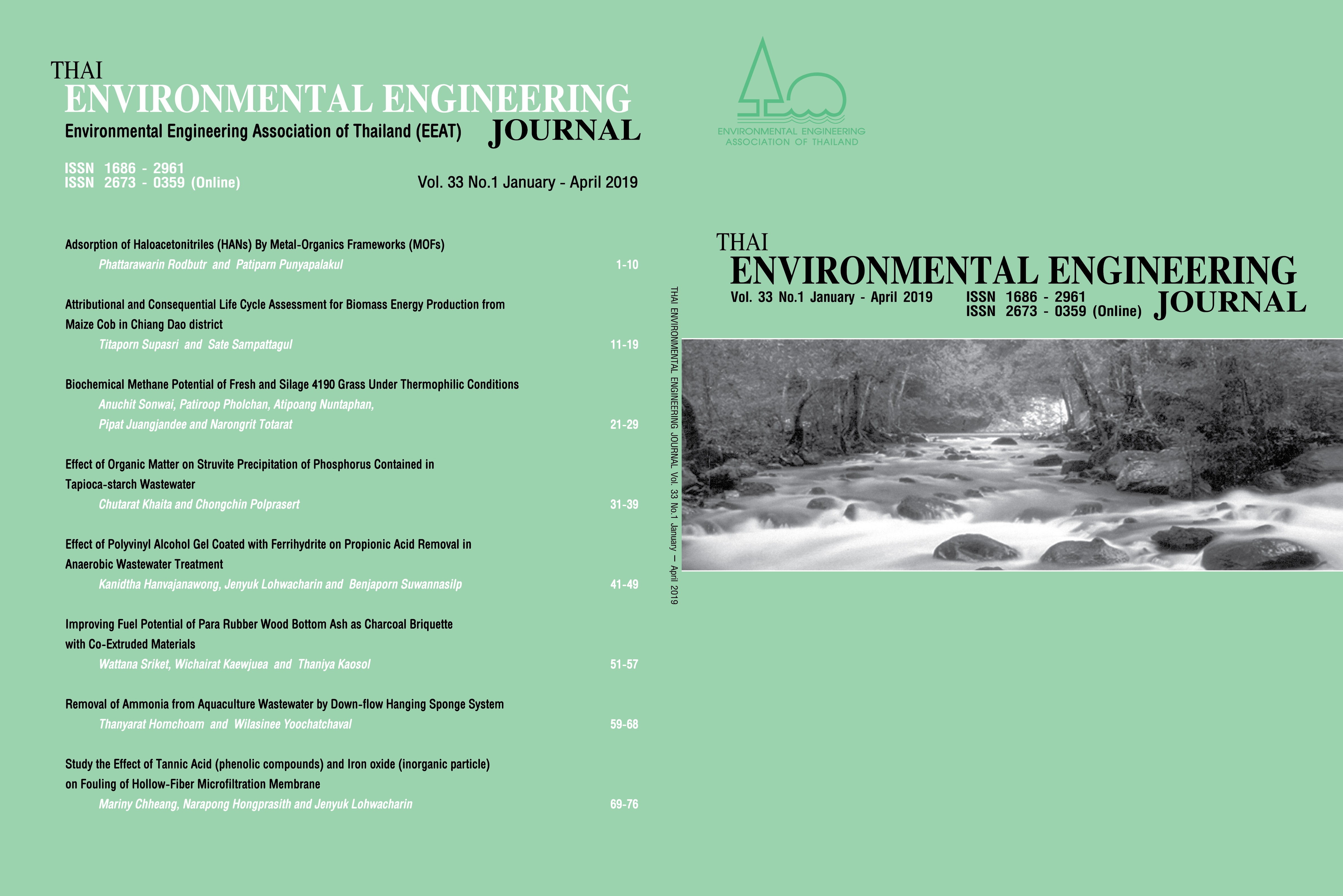Study the Effect of Tannic Acid (phenolic compounds) and Iron oxide (inorganic particle) on Fouling of Hollow-Fiber Microfiltration Membrane
Main Article Content
Abstract
Characteristics of membrane fouling by organic and inorganic foulants were investigated in this study. Two feed waters with organic matter (100 mg/L of tannic acid (TA)) and mixture of organic and inorganic matter (100 mg/L of tannic acid and 10 mg/L of Fe2O3 (TA-Fe2O3)) were tested. A bench-scale filtration experiment was tested on a PVDF hollow-fiber microfiltration (MF) with a nominal pore size of 0.02 µm. Filtration protocol included several steps i.e. filtration, physical cleaning, air scrubbing and drainage of retentate. The system was operated in a constant-flux dead-end mode of filtration. The operational parameter that represents membrane fouling was stopped when transmembrane pressure (TMP) reached 75 kPa for physical cleaning. Fouling on membrane was measured using digital pressure gauges. The quality of feed and permeate water were measured by checking total organic carbon (TOC), chemical oxygen demand (COD), total suspended solid (TSS), and turbidity. Filtration experiment was operated for 22 cycles within 10 days. Results of TOC and COD indicate that MF membrane could not reject organic compounds. Although after each cycle the membrane was soaked in NaOCl solution, irremovable fouling gradually increased, up to 36% of the maximum TMP after 22 filtration cycles. TSS and turbidity indicate that MF membrane can completely reject suspended solid in wastewater. TA-Fe2O3 water made MF membrane fouled faster than TA water alone. TMP at filtering TA-Fe2O3 increased faster than TA because the membrane surface was covered by accumulation of suspended solids. These results demonstrate that both feed water characteristics should be thoroughly investigated for appropriate operation of membrane processes.
Article Details
References
[2] Cassano, A., C. Conidi, and R. Castro-Muñoz. 2019. Current and Future Applications of Nanofiltration in Food Processing, in Separation of Functional Molecules in Food by Membrane Technology. Elsevier. 305-348.
[3] Hashino, M., et al. 2011. Effect of kinds of membrane materials on membrane fouling with BSA. J. Membrane Sci. 384(1-2): 157-165.
[4] Ravereau, J., et al. 2016. Ageing of polyvinylidene fluoride hollow fiber membranes in sodium hypochlorite solutions. J. Membrane Sci. 505: 174-184.
[5] Woo, Y.C., et al. 2013. Effect of chemical cleaning conditions on the flux recovery of fouled membrane. Desalin. Water Treat. 51(25-27): 5268-5274.
[6] Apha, A. 2005. WEF, 2005. Standard methods for the examination of water and wastewater. 21: 258-259.
[7] Field, R.W. and G.K. Pearce. 2011. Critical, sustainable and threshold fluxes for membrane filtration with water industry applications. Adv. Colloid Interface.
164(1-2): 38-44.
[8] Taniguchi, M., J.E. Kilduff, and G. Belfort. 2003. Modes of natural organic matter fouling during ultrafiltration. Environ. Sci. Technol. 37(8): 1676-1683.
[9] Louie, J.S., et al. 2006. Effects of polyether–polyamide block copolymer coating on performance and fouling of reverse osmosis membranes. J. Membrane Sci. 280(1-2): 762-770.


